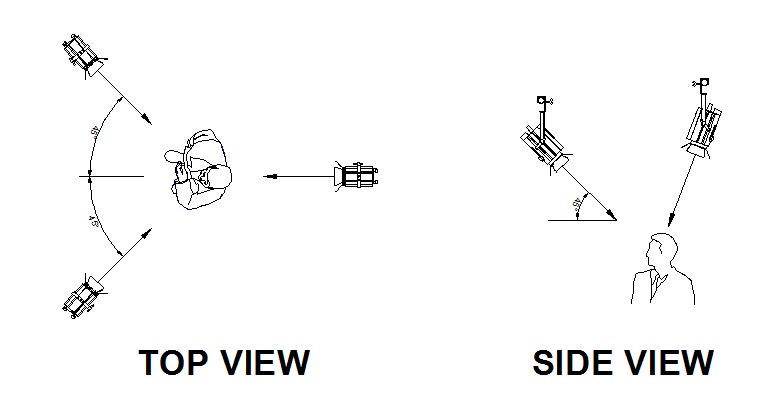Stage Lighting Basics
Theatre stage lighting is designed to make the stage performance visible to the audience, but the method used to light the stage will impact on the way the stage picture is perceived and should reinforce the overall dramatic impact of the production.
The most common method for lighting a theatre stage is called the McCandless System. Stanley McCandless wrote about this method in his 1932 book ‘A Method of Lighting the Stage’. His method was not meant to be the definitive method, but it is a useful guide based on his experience.
It can be described as a 3-point system: 2 lighting fixtures are placed in front of the subject and 1 fixture behind. The front fixtures are located at a 45-degree angle to the left and right of the subject and at an angle of 45-degrees above the subject. These locations illuminate the features of the subject well and ensure they appear natural and have 3-dimensional form. The angles of the light provide definition of form without causing deep, dark shadows under the eyebrows, nose, or chin. The location and angle also provide visibility as the subject turns their head from side to side.
Colour and intensity added to the front lights will provide visibility and definition. McCandless recommended using a warm colour in one front light, and a cool colour in the other. The colours blend for a natural appearance and contrast with each other to provide definition. The third light, or ‘backlight’, is placed behind and high overhead the subject, without being directly over the subject or shining in the audience’s eyes. This causes the subject to stand out from the background and further defines their form by lighting the back of the head and top of the shoulders. The colour of the backlight is usually “colouring the shadows” cast by the front lights, however, a halo effect can be created by using intense, warm backlight.
Theatre stage lighting design has four main functions in a theatrical performance, these aree: Visibility, Motivation, Composition and Mood each of which is described in more detail below.
Visibility doesn’t really need further explanation, the basic concept is that the stage lighting needs to illuminate things on stage that the audience should see and keep the lighitng off parts of the stage the audience shouldn’t see.
Motivation ensures that the stage lighting looks natural for the setting for example for a realistic interior scene at night the stage lights should appear to come from practical light fittings on the stage such as table lamps or chandeliers.
Composition is also a part of Scenic Design and is the Lighting Designer’s attempt to enhance the possibilities the Scenic Designer and Director have provided.
Mood is also a part of the other three functions – composition, motivation and the amount of light and kind of visibility all affect the mood of a production.
In order to provide good quality theatre stage lighting design most lighting is designed as a group of acting areas. The luminaires lighting each acting area are arranged to achieve the desired visibility, to adequately reveal the actor’s form and to make sure the actor appears separate and distinct from the scenic background.





